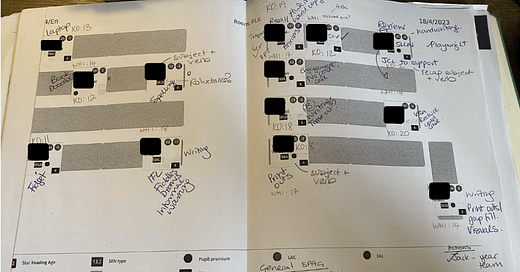David Didau posted a blog about this, called messy registers. This photo is what a messy register looks like.
You track the room, and all the students in it, making notes which helps you question them more precisely, with more nuance. Didau makes copious notes on a whiteboard.
You keep records moment by moment of who has answered a question, and who hasn’t.
You can read the blog here.
It is entirely possible that this complexity leads to much better learning. I just don’t believe it does.
I think simplicity is the key to any approach you take in the classroom. Simple solutions are scale-able, repeatable, habit forming. There is never a day when a simple technique is too much hassle.
Here are 4 simple ideas:
Cold call as often as you can.
Put students’ work under the visualiser as often as you can.
Choose their work at random.
Use a timer for all your activities.
You don’t have to plan or record any of this. Just doing it will be enough.
If you want to see how these work in a lesson, I’ve written about it here.





Thanks Phil, using it that way, to diagnose the class sounds very efficient and I completely agree with you. Thanks for your really thought provoking and informative comment too.
As usual, I think we agree and I am maybe guilty of over-simplifying my example.
What I found relevant and worth sharing with my colleague's use of Kahoot was the way it provided him with some immediate sense of how many students had answered correctly or incorrectly to steer his upcoming teaching in that lesson. He and the students were not really interested in the league table and it struck me that it allowed him to, in effect, 'cold-call' the whole class at once by displaying the question then interrogating some of the answers without necessarily exposing individual students - for example one question was answered incorrectly by the majority - enabling him to correct and engage the students who had answered correctly to assist in this. Perhaps more a common misapplication rather than a misconception then.
It was formative therefore where every other time I've seen this used it has been summative.
The relevance to your thread was that whilst I didn't think I would have the discipline or need to keep Didau-style annotations, I thought it provided the teacher a more concrete analysis of what was known/not known on which to base his planning - as you say, better than cold-calling an individual would.
He wasn't considering Kahoot in terms of motivating students but as a tool - to simplify his own mental register annotating. It was 5 minutes pre register that I felt was very purposeful...and completely different to how I've seen this tool used previously. It struck me he gained a lot of useful info, quickly and efficiently without needing to do anything other than 'do it'.